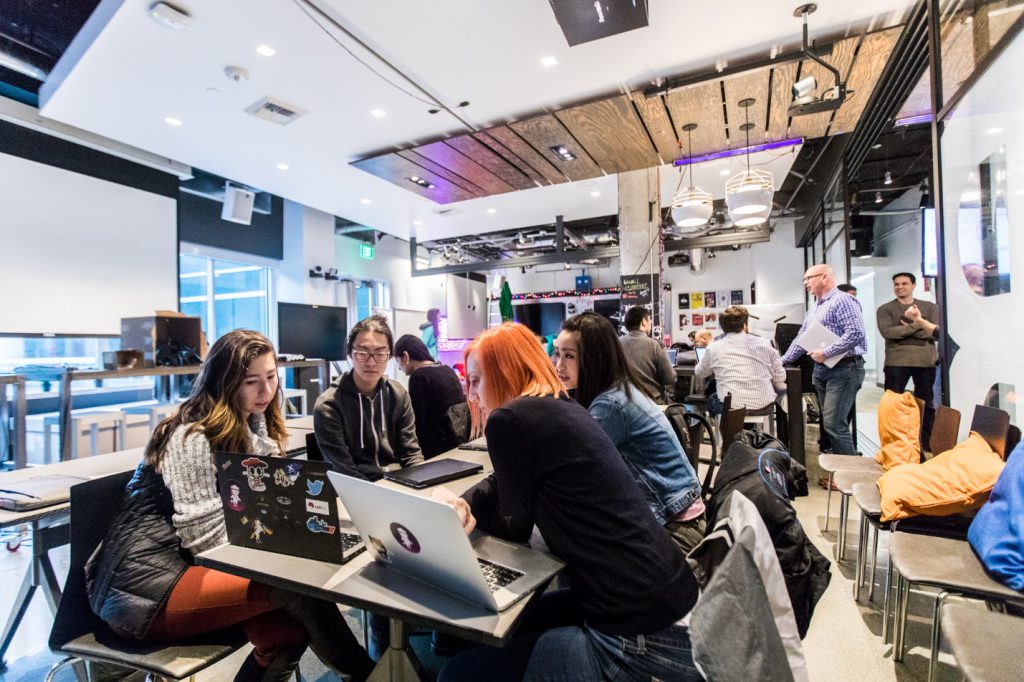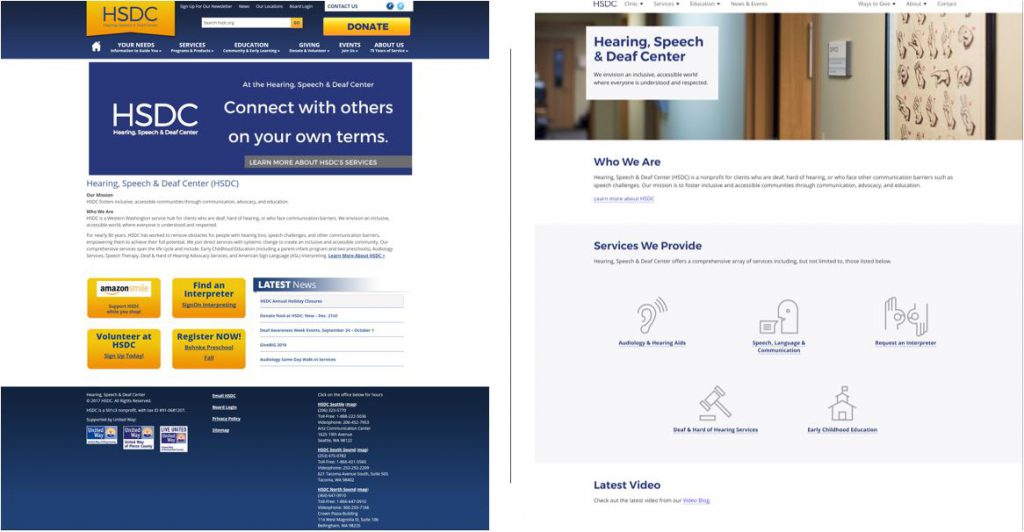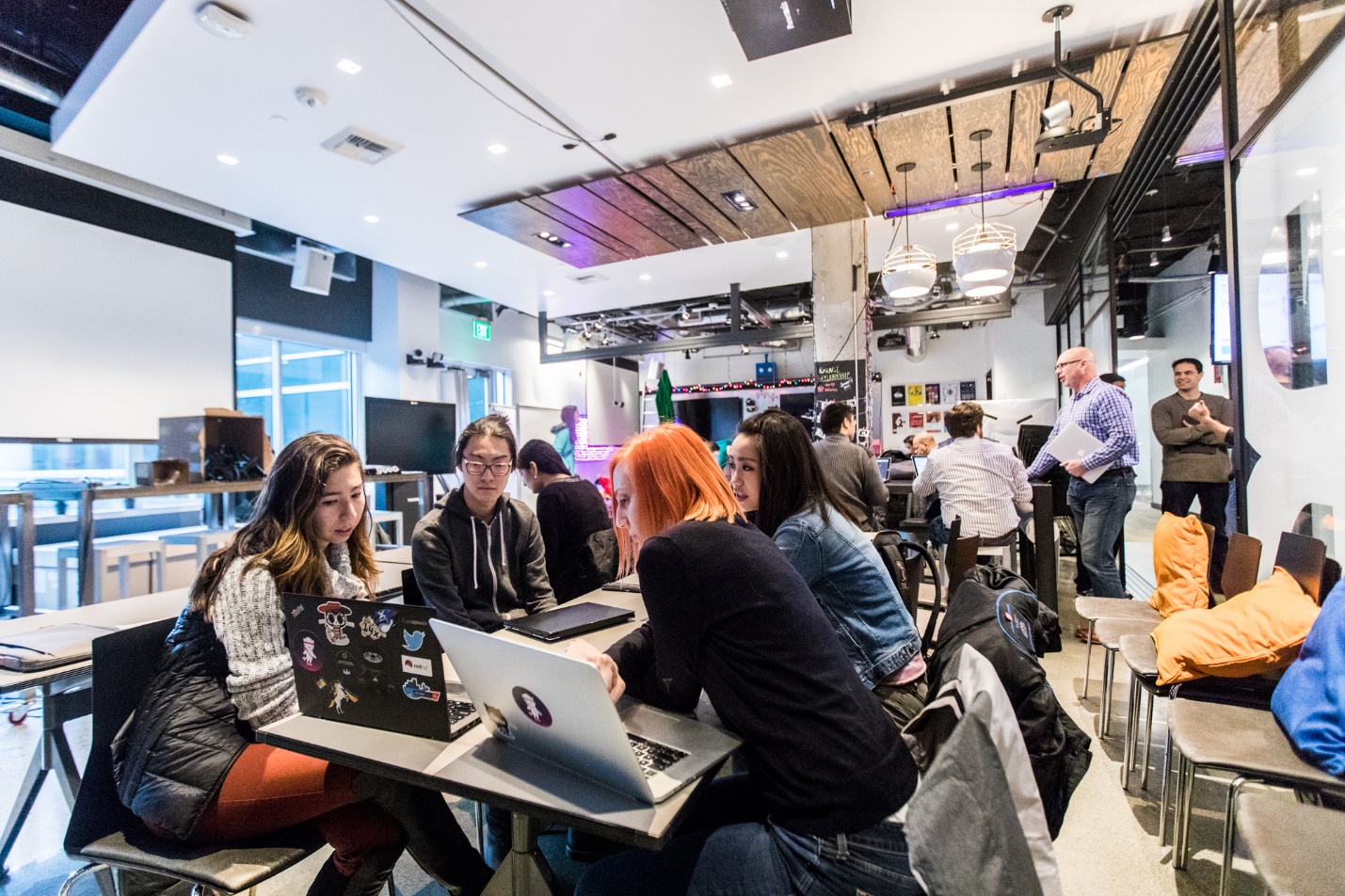The following article was distributed internally within Microsoft, and has been republished with permission.
How these employees got out of their bubble to help a nonprofit create a more accessible world

Sara and fellow volunteers work on building the new HSDC website in The Garage in Redmond, January 2017. From left to right: Sara Clayton, Chris Su, Alycia Moncrieff, and Zoe Zou.
By Rebekah Schilperoort
When Sara Clayton signed up for a volunteer project last October, she had no idea she’d help an 80-year-old nonprofit find its digital footing and make it easier for thousands of deaf people to find the services they need.
In high school and college, Sara found plenty of ways to help her community. But in her second year as a UX designer with Microsoft Stores, she was having trouble finding an opportunity that balanced with her day job. So, when the chance came up to lead a group of a dozen employee volunteers – from coders to marketers – to create accessible digital platforms for Hearing, Speech, and Deaf Center (HSDC), she took it.
For eight decades, HSDC has been a service hub for people in the Seattle area who are deaf, hard of hearing, or who face communication barriers. Due to funding loss, the organization has struggled in recent years to boost awareness of its programs and keep up with the latest technology to better serve its clients, most of whom are low income.
To grow, the nonprofit needed an accessible, modern website, a plan to engage with a burgeoning social media audience, and a way to shed outdated practices for collecting vital client data.
“We want to be leaders in the community,” said Renee Look, HSDC Development Director. “And we need to be in the 21st Century to do that.”
This eight-month, skills-based volunteering project was part of a Microsoft Philanthropies pilot initiative that allows employees to drive social impact by using their skills outside of work hours to help solve challenges facing nonprofits. Employees gain powerful new perspectives and leadership skills, while organizations gain insights from passionate volunteers.
This strategic level of volunteering allows nonprofits like HSDC to benefit from skillsets it wouldn’t otherwise be able to afford.
“As a nonprofit, you’re always just trying to stay alive,” said the center’s Executive Director Lindsay Klarman. “For us, this was an opportunity to take care of our existing clients, but also blow the doors open and see who else we could be helping.”
A digital transformation
Sara saw the project not only as a way to “practice true customer obsession,” but also as an opportunity to bring a deserving organization into the spotlight.
“This was the perfect chance to combine strategic thinking and design to actually make an impact,” said Sara, who acted as project manager and designer. “Hearing about the center’s needs and figuring how to meet them was really rewarding.”
The old HSDC website wasn’t compatible with screen readers and didn’t meet accessibility standards for people with vision or hearing challenges. It was cluttered, and difficult to find forms and basic information. Sara recalls one deaf family who had trouble getting in touch with the center because they couldn’t find the online contact form. In fact, many clients would call the center rather than go through the website.
Today, the new website works seamlessly with screen readers. Services are prominent in the navigation, hyperlinks are clearly marked with dotted lines, and color contrast makes everything easy to read. Alycia Moncrieff, web developer from the Digital Stores team, lent her expertise to develop the site so it’s accessible for all abilities and assistive technologies.

Before and after: The old HSDC website (left) did not meet accessibility standards. The new website design (right) is modern and works seamlessly with screen readers.
For a client to request an interpreter or hearing test, they used to have to print a form, fill it out, and mail it back to the center. Now, those forms are submitted online with the click of a button.
“It’s a total game-changer,” said Lindsay. “One of our core principles is to remove communication barriers and having great technology can help do that.”
Marina Mazhukhina, a senior data analyst in our Human Resources department, and Maria Chan, a user researcher in our WDG Research group, worked on another transformative aspect of the project – digitizing client surveys. For decades, HSDC recorded client data on paper, but it was getting lost or filed and never looked at again.
Through gap analysis and client interviews, Marina and Maria developed new online surveys to collect data on client satisfaction and each of the nonprofit’s five service areas. The data can be analyzed through the online platform, which is integral for grant applications, said Lindsay.
“The fact that we can now establish a baseline for our current clientele, and then see where those growth opportunities are, is so valuable,” she said.
Microsoft also donated seven tablets – eliminating the need for paper and clipboards in the waiting room.
“It really enhances the patient experience,” Marina said. “As soon as clients walk in, they can fill out the survey and HSDC will get real-time data to take the pulse of the population they serve.”
The power of social media
Social sites like Facebook, Twitter, and Instagram – where users can share ideas through videos and images – have helped bridge the gap between the deaf and hearing worlds. But HSDC lacked a strategy, and the staff, to leverage those channels.
Colleen O’Brien, a product marketing manager for Windows, volunteered her time to develop tactics for the center to boost its social reach, increase visibility, and recruit volunteers. She saw how valuable her skills were to a nonprofit without the resources to hire an expert.
“It was a fantastic opportunity to help them generate more value from what might otherwise be a tax on their time,” Colleen said.
And it’s working. After just one month of implementing Colleen’s strategy, the center saw a more than 15-percent rise in engagement on Facebook and Twitter.
“It’s a big deal,” Renee said. “Because of Microsoft, we have a plan that’s allowing us to increase visibility and awareness.”
On a stormy Thursday afternoon, HSDC’s 80th birthday celebration is underway at the center’s headquarters in Seattle’s Capitol Hill neighborhood. Clients and friends of the center are standing in groups, laughing, hands flying in silent, but animated conversations in American Sign Language.
Lindsay climbs on top of a chair and begins signing and speaking loudly to get everyone’s attention. She tells the crowd the new website and surveys are ground-breaking, but it’s just the start. More innovations are needed to ensure the center sticks around for another 80 years.

HSDC Executive Director Lindsay Klarman signs to the crowd at the center’s 80th birthday celebration.
For Sara, working with new colleagues and getting to know HSDC staff has been inspiring. She hopes the digital enhancements will help the center reach more people whose lives could be improved through its services.
“They’re so passionate about what they do,” said Sara. “They aren’t seeking gain – they just want to help more people.”
